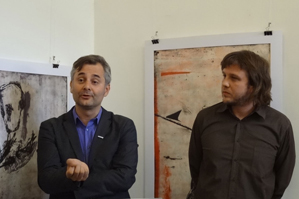Where art and science intersect

The following post was generously contributed by Santiago Gil, a postdoctoral research associate at Northeastern’s Center for Complex Network Research.
Botond Részegh and Albert-László Barabási share a singular history. Both were born in a small village near Csíkszereda, in Transylvannia, as part of the Hungarian minority in Romania. They lived through an oppressing dictatorship, through hardship and scarcity.
Their journeys, though, have been quite different. Barabási became a world-renowned scientist and distiguished professor of international acclaim who lectures around the globe and sat on the Global Agenda Council of the World Economic Forum. Részegh stayed in his village; he’s a quiet man who feels most comfortable in the intimacy of small crowds, or in the privacy of his studio.
But they seem to have a common essence: Barabási’s science is intrepid and visionary, and Részegh’s art is emotional and tempestuous. A common love for literature brought them together. They were introduced by the great poet Sándor Kányádi and together birthed a book, Bursts, written by Barabási and illustrated by Részegh.
Since then they have developed a friendship, on which they had the opportunity to reminisce as they sat together for a conversation on Friday, Feb. 28 at Northeastern University’s Visitor Center moderated by associate professor of graphic design, Isabel Meirelles. Through Meirelles’ direction and their dialogue with the audience, the duo explored the different roads they traveled, and to find where they meet.
Részegh proclaimed that his work is always full of subjectivity and he never wants to be objective. For his part, Barabási asserted that the execution of science is supposed to be objective, but that there is a lot of subjectivity in choosing a problem and how it should be addressed. The audience sensed that both approaches are two aspects of the same quest, an insatiable curiosity and a search for truth. Részegh described his practice as sampling and collecting experiences from different people as if they were measurements from an experiment.
“I think I’m both a filter and a catalyzer of my experiences,” said Részegh, explaining that his job is to coerce them into one unified expression. Sometimes he likes to think of himself as a neutrino, traveling freely through everything, going through all of our minds.
“Science has the constraint that it has to correspond to reality, but in art there are also a lot of constraints,” added Barabási. After all, is the true artist not obliged to remain faithful to his own reality?
They eventually arrived at the question of the responsibilities that art and science have toward society. Barabási reminded us of the days in which artists and poets led social movements, like the Hungarian revolution of 1848. But nowadays, technology is often associated with democratic movements, and scientific evidence is increasingly important for novel policy-making.
Barabási asked, “Has art lost its ability to really engage the public? Has science?” Science, he added, is routinely confronted with its responsibilities. This is true today more than ever, as personal data from millions of people are constantly funneled into research. But the pressures of the markets and the culture of superstar artists seem to have locked our art away into institutional sanctuaries. “Art is boxed into the art paradise, into a zoo of art,” he lamented. “We’re losing something as a society by not bringing the artists’ perspective in.” As we transit ever more rapidly changing cultural landscapes, we must break art out of its box and restore it to its rightful place as a beacon of light to help us navigate uncharted territories.
Barabási told us that the ground is clearly shifting. “The art and the science communities have been coming together dramatically,” he said, noting the increasingly recognized value of communicating science and the artistic dimension of data visualization, digital artist Aaron Koblin‘s flight pattern series. In turn, science inspires artists who emphasize experimentation and produce their work in groups that resemble a research lab more than a traditional artist’s studio, such as Tomás Saraceno and Olafur Eliasson.
“We have a responsibility to continue these discussions, because I think it’s beneficial to both communities,” Barabási said. Undoubtedly, they are also beneficial for society as a whole.






